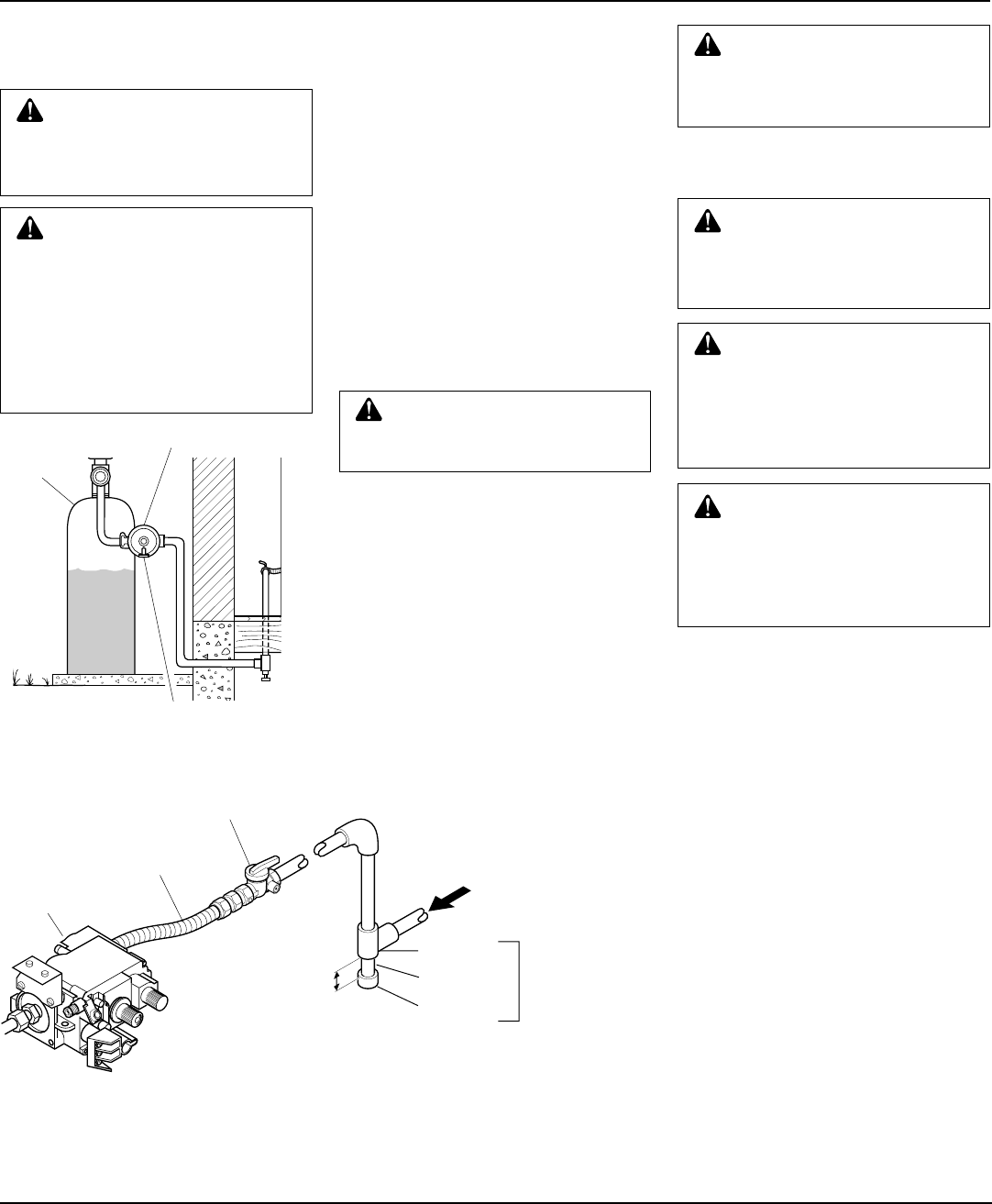
12
105190
UNVENTED PROPANE/LP GAS LOG HEATER
VANGUARD
INSTALLATION
Continued
Figure 15 - Gas Connection
* Purchase the optional CSA design-certified equipment shutoff valve from your dealer. See
Accessories, page 24.
** Minimum inlet pressure for purpose of input adjustment.
3" Minimum
Sediment
Trap
Gas Control
From External
Regulator (11"
W.C.** to 14"
W.C. Pressure)
CSA Design-Certified Equipment
Shutoff Valve With 1/8" NPT Tap*
Approved Flexible Gas Hose
(if allowed by local codes)
Tee Joint
Pipe Nipple
Cap
WARNING: Never connect
heater to private (non-utility) gas
wells. This gas is commonly
known as wellhead gas.
Installation must include an equipment
shutoff valve, union, and plugged 1/8" NPT
tap. Locate NPT tap within reach for test
gauge hook up. NPT tap must be upstream
from heater (see Figure 15).
IMPORTANT:
Install an equipment shutoff
valve in an accessible location. The equip-
ment shutoff valve is for turning on or
shutting off the gas to the appliance.
Check your building codes for any special
requirements for locating equipment shutoff
valve to fireplace.
Apply pipe joint sealant lightly to male NPT
threads. This will prevent excess sealant
from going into pipe. Excess sealant in pipe
could result in clogged heater valves.
CAUTION: Use only new,
black iron or steel pipe. Inter-
nally-tinned copper tubing may
be used in certain areas. Check
your local codes. Use pipe of 1/2"
diameter or greater to allow
proper gas volume to heater. If
pipe is too small, undue loss of
volume will occur.
We recommend that you install a sediment
trap in supply line as shown in Figure 15.
Locate sediment trap where it is within
reach for cleaning. Install in piping system
between fuel supply and heater. Locate sedi-
ment trap where trapped matter is not likely
to freeze. A sediment trap traps moisture
and contaminants. This keeps them from
going into heater controls. If sediment trap
is not installed or is installed wrong, heater
may not run properly.
WARNING: Use pipe joint seal-
ant that is resistant to liquid pe-
troleum (LP) gas.
CAUTION: Avoid damage to
control. Hold fitting with wrench
when connecting it to gas piping
and/or fittings.
Figure 14 - External Regulator With Vent
Pointing Down
Propane/LP
Supply
Tank
External Regulator
Vent Pointing Down
WARNING: Never use an open
flame to check for a leak. Apply a
noncorrosive leak detection fluid
to all joints. Bubbles forming
show a leak. Correct all leaks at
once.
WARNING: Test all gas pip-
ing and connections for leaks
after installing or servicing. Cor-
rect all leaks at once.
CAUTION: Make sure exter-
nal regulator has been installed
between propane/LP supply and
heater. See guidelines under
Con-
necting to Gas Supply
, pages 11
and 12.
CHECKING GAS
CONNECTIONS
Pressure Testing Gas Supply
Piping System
Test Pressures In Excess Of 1/2 PSIG
(3.5 kPa)
1. Disconnect appliance with its appliance
main gas valve (control valve) and equip-
ment shutoff valve from gas supply pip-
ing system. Pressures in excess of 1/2 psig
will damage heater regulator.
2. Cap off open end of gas pipe where
equipment shutoff valve was connected.
3. Pressurize supply piping system by ei-
ther using compressed air or opening
propane/LP supply tank valve.
4. Check all joints of gas supply piping
system. Apply a noncorrosive leak de-
tection fluid to gas joints. Bubbles
forming show a leak.
5. Correct all leaks at once.
6. Reconnect heater and equipment
shutoff valve to gas supply. Check re-
connected fittings for leaks.
